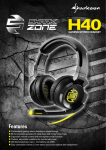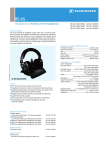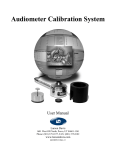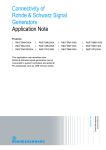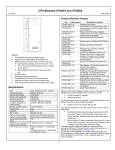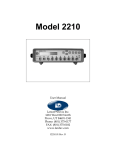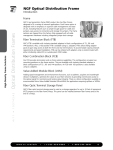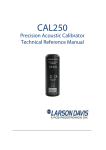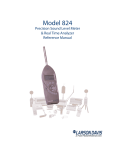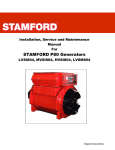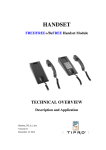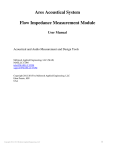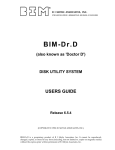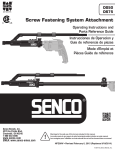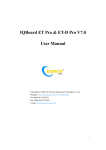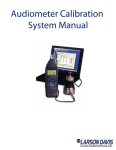Download AEC101 Manual CH 2.book
Transcript
AEC101 IEC318 Artificial Ear Coupler User Manual Larson Davis 1681 West 820 North, Provo, UT 84601-1341 Phone: (801) 375-0177, FAX: (801) 375-0182 www.larsondavis.com IAEC101.01 Rev. A AEC101 User Manual Trademarks PC is a trademark and IBM is a registered trademark of International Business Machines Corporation. Intel is a registered trademark of Intel Corporation. Windows 95, Windows 98, and Windows NT are registered trademarks of Microsoft Corporation. Other product and company names may be mentioned in this manual which are trademarks of their respective owners. Disclaimer Even though Larson Davis has reviewed thiedocumentation, Larson Davis makes no warranty or representation, either expressed or implied, with respect to this documentation, its quality, performance, merchantability, or fitness for a particular purpose. This documentation is subject to change without notice, and should not be construed as a commitment or representation by Larson Davis. Support Policy Please retain the serial number, and purchase date of your AEC101. You may be asked to provide this information when contacting Larson Davis for service or technical support. Warranty Larson Davis warrants this product to be free from defects in material and workmanship for two years from the date of original purchase. During the first year of warranty period, Larson Davis will repair or, at its option, replace any defective component(s) without charge for parts or labor if the unit is returned, freight prepaid, to an authorized service center. The product will be returned freight prepaid. During the second year warranty period, there will be no charge for replacement parts provided the product is returned to a Larson Davis repair facility. Product defects caused by misuse, accidents, or user modification are not covered by this warranty. The warranties described above are exclusive and in lieu of all other warranties whether statutory, express or implied including, but not limited to, any implied warranty of merchantability or fitness for a particular purpose and all warranties arising from the course of dealing or usage or trade. The buyer’s sole and exclusive remedy is for repair or replacement of the non-conforming product or part thereof, or refund of the purchase price, but in no event shall Larson Davis, its contractors and suppliers be liable for any special, indirect, incidental, or consequential damages, whether the claims are based in contract, in tort (including negligence), or otherwise with respect to or arising out of the product furnished hereunder. Representation and warranties made by any person, including authorized dealers, representatives and employees of Larson Davis which alter or are in addition to the terms of this warranty shall not be binding upon Larson Davis unless in writing and signed by one of its officers. ii AEC101 User Manual Calibration and Certification Services Larson Davis offers NIST traceable calibration services compliant with ISO 10012. Remember that your microphone and preamplifier are an important part of your acoustic measurement system, and it is important that your system is properly calibrated by people who understand the complexities of these components. Larson Davis encourages you to return your system to the factory for calibration each year thus validating the accuracy and quality of your measurement with a factory calibration certificate. Please refer to the Larson Davis price list for details of cost or contact the factory or your Larson Davis Representative for details. In many cases, engineering improvements and firmware upgrades are included with calibration at no additional cost. As an additional incentive to take advantage of our calibration services, Larson Davis will extend the labor warranty by another year following a paid calibration certification. iii AEC101 User Manual iv AEC101 USER MANUAL Table of Contents Chapter 1 Introduction 1-1 The AEC101 IEC 318 Artificial Ear Coupler.........................................................1-1 Construction............................................................................................................1-2 Standards.................................................................................................................1-2 About this manual ...................................................................................................1-3 Measurements .........................................................................................................1-3 Audiometer Calibration......................................................................................1-3 Earphone Frequency Response Production Testing...........................................1-4 Chapter 2 AEC101 IEC 318 Coupler Initial Inspection and Assembly 2-1 AEC101 IEC 318 Coupler SPL Calibration ...........................................................2-4 Chapter 3 Testing Transducers with the AEC101 3-1 Audiometer Transducer Test Configurations .........................................................3-1 Testing Supra-Aural Earphones with the AEC101.................................................3-2 Testing Circumaural Earphones with the AEC101.................................................3-4 Environmental conditions ..................................................................................3-4 Test Configurations............................................................................................3-4 Appendix A AEC101 Specifications .............................................................. AA-1 Standards.............................................................................................................AA-1 Physical ...............................................................................................................AA-2 Appendix B AEC101 Verification or Calibration .........................................AB-1 Safety Precautions............................................................................................... AB-1 Equipment & Materials....................................................................................... AB-1 Verification ......................................................................................................... AB-2 Tuning ................................................................................................................. AB-4 i AEC101 USER MANUAL ii C H A PT E R 1 Introduction The AEC101 IEC 318 Artificial Ear Coupler Thank you for choosing the Larson Davis AEC101 IEC 318 Artificial Ear Coupler. The AEC101coupler is an ear simulator covering the frequency band from 20 to 10000 Hz, which has been designed for the calibration of supra-aural earphones used in audiometry and telephonometry applied to the ear without acoustical leakage. The AEC101 allows accurate and repeatable measurements within its frequency response. This coupler is part of the Larson Davis family of products for audiometer calibration and electro-acoustic test. With the other components of LD audiometer calibration systems, it provides a durable means of calibrating and testing many types of electro-acoustic transducers. It may also be used for production testing where correlation between the coupler and real ear response is not a requisite. August 26, 1999 Introduction 1-1 Construction The AEC101 is composed of three cavities coupled by precise acoustical volumes. The main cavity includes a 1/2" microphone (LD 2559, not included) which is connected to the preamplifier inserted in the base of the coupler via a teflon insulator with gold plated contacts and stainless steel spring-loaded pin. Major mechanical parts are made of nonmagnetic stainless steel for hardness, finish and long lasting quality. The base has a non-skid rubber bottom and a vibration isolation pad is provided with the system. In use, a supra-aural earphone is securely contained by an earphone retainer ring made of durable black anodized aluminum. Clamping force is supplied by a stainless steelweight (4.5 N) lowered in the retainer ring. This approach adapts to different earphones and avoids having to adjust complex spring loaded mechanisms. The AEC101 also includes two adapter plates and a heftier flexible bag weight (9.5N) required for circumaural earphone testing. Standards The AEC101 was designed to achieve the characteristics defined in International Electrotechnical Commission IEC 60318-1:1998 Ear simulator for the calibration of supraaural earphones. The AEC101 coupler also meets the requirements of the American National Standard ANSI S3.7-1995 Methods for Coupler Calibration of Earphones (section 5.4). It is used with the Larson Davis 2559 precision 1/2" random incidence microphone and a measuring system, typically the PRM902 preamplifier and System 824 realtime analyzer/sound level meter. With the help of adapter plates described in IEC 60318-3 An interim acoustic coupler for the calibration of audiometric earphones in the extended high-frequency range, and in ANSI S3.7-1995 Methods for Coupler Calibration of Earphones (Annex C), the AEC101 may also serve to calibrate 1-2 AEC101 User Manual August 26, 1999 specific high acoustic damping earphones in the range from 8 kHz up to 16 kHz. About this manual This manual describes the care and usage of your AEC101 IEC 318 Artificial Ear Coupler and accessories. The following subjects will be covered: Chapter 1 - Introduction: overview of AEC101 properties and standards Chapter 2 - Initial Inspection, Assembly and Calibration: initial familiarization with the AEC101 components, assembly to a typical measurement system (System824) and calibration Chapter 3 - Testing Transducers with the AEC101: setup and procedures for the test and calibration of earphones Appendix A - Calibration Method: description of the procedure used to calibrate and verify the AEC101 stability Appendix B - Specifications Measurements The Larson Davis AEC101 IEC 318 Artificial Ear Coupler may be used for a number of precision electro-acoustic test applications, such as audiometer calibration and earphone frequency response production testing. Audiometer Calibration The accuracy of an individual's hearing evaluation is extremely important for clinical, legal, as well as personal reasons. The audiometers used to quantify hearing loss are complex instruments. They include signal generation, presentation and electro-acoustic components which must be verified periodically to ensure accuracy and repeatability. August 26, 1999 Introduction 1-3 Audiometers are often located in test areas which must also be tested for ambient noise, and it is preferable not to remove them from their installation. Therefore, portable calibration systems are indicated. The Larson Davis AEC101 IEC 318 Artificial Ear Coupler is ideal for a lightweight portable calibration system. It may be added to the LD SYS008 and SYS009 audiometer calibration systems, which include a precision sound level meter (System824) and software (AUDit™) to perform exhaustive calibration according to the American National Standards Institute ANSI S3.7-1995 Methods for Coupler Calibration of Earphones and S3.6-1996 Specification for Audiometers. Earphone Frequency Response Production Testing As is the case with other artificial ear couplers, the AEC101 approximates the average human ear only for a limited frequency range and with certain earphones. The measured responses may be significantly different from one earphone type to another. However, an exact correlation is not always required for production testing. It is possible to use the AEC101 as part of an accurate system for production testing of earphones or other electro-acoustic transducers. Such a system may consist of the following components: • Test earphone and adapter to AEC101 • Larson Davis Model AEC101 coupler • Larson Davis Model 2559 1/2" microphone • Cable from earphone connector to BNC output of source • Larson Davis Model SRC20 synthesized signal source • Precision amplifier (if required) • Precision sound level meter such as Larson Davis Model 824-Lite or 824 with frequency analysis capability. Frequency response, level linearity and harmonic distortion can be measured using the signal generation capability of the SRC20, the coupler and precision sound level meter. 1-4 AEC101 User Manual August 26, 1999 C H A PT E R 2 AEC101 IEC 318 Coupler Initial Inspection and Assembly The AEC101 IEC 318 Coupler is available in a variety of configurations. You may have purchased the coupler alone, with various accessories, or within a complete audiometer test system. In this chapter, the initial inspection of the AEC101 will be covered. You will also assemble an AEC101 and connect it to a measurement system, in this case the System 824 precision real-time sound level meter/ analyzer. For this you will need: Part Number Description AUDit™ AUDit™ software running on a PC CBL006 serial cable Serial cable 8 pin mini DIN to DB-9 824 System824 precision sound level meter (SLM) EXA010 10 foot extension cable with 7 pin LEMO connectors 2559 1/2" precision air condenser random incidence microphone PRM902 1/2" diameter low noise microphone preamplifier CAL250 Precision SPL calibrator with 114 dB SPL output at 250 Hz with 1 to 1/2" calibrator opening adaptor The following are AEC101 components: Artificial ear base including base, contacts, insulator and pad IEC 318 coupler MAEC101.06 IEC 318 Type 1 adaptor MAEC101.07 IEC 318 Type 2 adaptor MAEC101.08 IEC 318 conical ring MAE100.6 Earphone retainer ring MAEC100.7 Mass handle SAEC100.01 Weight assembly ACC001 Vibration isolation pad WARNING! September 8, 1999 Before continuing, ensure that the 824 SLM is turned off. Sensitive circuitry may be adversely affected by transients during assembly if the 824 is on. The 824 should remain off until the system is fully assembled. AEC101 IEC 318 Coupler Initial Inspection and Assembly 2-1 The AEC101 artificial ear is a versatile coupler and allows measurement of a variety of earphones with its provided accessories. Read the following instructions to unpack, inspect and assemble the coupler for the first time. Step 1 Place the cushioned vibration isolation pad on a table or other such stable surface near the audiometer system. Step 2 Visually inspect the coupler for gouges, scratches and dents which may affect the measurement, especially around the sharp lip which will be in contact with the test earphone. Verify that the small tube in the capillary leak hole is present with no other obstructions (figure 2-1). Leak Hole Figure 2-1 AEC101 with coupler, leak hole Step 3 2-2 Check the threaded hole on the weight assembly (SAEC100.01) for obstructions, and screw in the mass handle (MAEC100.7). The handle should screw in securely. AEC101 User Manual September 8, 1999 Step 4 If installed, remove the coupler from the artificial ear base by gently unscrewing it counterclockwise. Step 5 Inspect the spring-loaded contact at the center of the base visually. It should extend approximately 5 mm above the threaded ridge. The teflon insulator around it should be free of dust and other particles. Please do not handle the contact and protect it by keeping the coupler on whenever a microphone is not installed. Step 6 Working over the cushioned pad (ACC001), install the 1/2" microphone (LD Model 2559 or equivalent) on the center of the artificial ear base. The microphone should install easily: screw it finger tight (figure 2-2). Figure 2-2 Microphone installed on AEC101 Step 7 September 8, 1999 Insert the 1/2" microphone preamplifier (LD Model PRM902 or equivalent) gently in the side port until its threads contact those of the base. The preamplifier should install easily: screw it finger tight (figure 2-3). AEC101 IEC 318 Coupler Initial Inspection and Assembly 2-3 NOTE: When removing the preamplifier, unscrew it by holding on its body, not the connector sleeve . Figure 2-3 Preamp being installed in the AEC101 Step 8 Connect the instrument cable to the preamplifier. The coupler is now ready for level calibration. AEC101 IEC 318 Coupler SPL Calibration NOTE: You will need to install the adapter (ADP019) into the CAL250 in order to calibrate 1/2 inch microphones. ADP019 2-4 Level calibration is performed with the Larson Davis Model CAL250 precision calibrator. It offers a level of 114 dB with an accuracy of +/-0.2 dB at 250Hz. You will have to insert the provided 1" to 1/2" adaptor in the top of the calibrator. To calibrate the measurement system and artificial ear, follow the procedure below. Step 1 Assemble the coupler as described in the Initial Inspection and Assembly section above. The coupler base should rest on the isolation pad and ambient noise and vibration should be minimized. AEC101 User Manual September 8, 1999 NOTE: Do not remove the microphone grid cap. Step 2 Place the calibrator opening on the microphone and seat it fully (figure 4-4). Figure 2-4 Installing the CAL250 on AEC101 Step 3 Activate the calibrator as prompted by the software and verify the stability of the indication on the measurement system (figure 4-5). Do not hold the calibrator during calibration. Its tone will last about one minute (depending on the battery) and will turn off automatically. Figure 2-5 CAL250 being activated on AEC101 September 8, 1999 AEC101 IEC 318 Coupler Initial Inspection and Assembly 2-5 2-6 AEC101 User Manual September 8, 1999 C H A PT E R 3 Testing Transducers with the AEC101 This chapter covers test configurations for the audiometer transducers which can calibrated with the LD AEC101 Please contact Larson Davis if you have any system assembly questions not covered in this manual. Audiometer Transducer Test Configurations The table below lists some typical audiometer transducers, many of which are covered in specifications such as American National Standards Institute Specifications for Audiometers, S3.6-1996. These test setups are covered in greater detail in subsequent sections. Transducer Type Example Suggested Setup Comments Supra-aural earphone Telephonics TDH-39, 49, 50 AEC100 NBS 9-A coupler or AEC101 IEC 318 artificial ear Use 4-5 N weight. Test up to 8000 Hz. Circumaural earphone Sennheiser HDA200 AEC101 IEC 318 artificial ear with MAEC101.06 Type 1 adaptor plate Use 9-10N weight. Extended frequency tests up to 16000 Hz may be performed. Circumaural earphone Koss HV/1A AEC101 IEC 318 artificial ear with MAEC101.07 Type 2 adaptor plate Use 9-10N weight. Extended frequency tests up to 16000 Hz may be performed. September 8, 1999 Testing Transducers with the AEC101 3-1 Testing Supra-Aural Earphones with the AEC101 The following steps are suggested for audiometer calibration with the AEC101. Step 1 Assemble the coupler as described in the Initial Assembly Chapter. The coupler base should rest on the isolation pad and ambient noise and vibration should be minimized. Step 2 Perform a calibration of the system as described in the Calibration Chapter above. Step 3 As desired, apply sealant on the lower portion of the microphone to prevent air leakage from the coupler through paths other than the capillary leak hole. Screw the coupler over the base (figure 3-1) until finger tight. The sealant should not affect the volume of the cavity or occlude the leak hole. Figure 3-1 Coupler being installed on AEC101 Step 4 Place the black conical ring (figure 3-2) on the top of the coupler. Black Ring installed Figure 3-2 Black Conical ring installed on AEC101 3-2 AEC101 User Manual September 8, 1999 Step 5 For headphones with a very stiff ear cap, apply a thin (less than 1mm) film of sealant or rubber sheet on the contact area between coupler and earphone. Step 6 Center the test earphone on the coupler. Lower the black retainer ring over the earphone, holding the earphone cable in line with the notch (figure 3-3). Figure 3-3 Retainer ring being installed on AEC101 Step 7 Lower the mass by its handle to the top of the earphone (figure 3-3). Figure 3-4 Mass being lowered onto headphone. The coupler and earphone are now ready for measurement. Set tone type, level and presentation and make the reading on the measurement system. September 8, 1999 Testing Transducers with the AEC101 3-3 Testing Circumaural Earphones with the AEC101 Circumaural earphones are available for audiometers using extended high-frequencies, from 8000 to 16000 Hz. These earphones typically rest against the head with little or no contact with the pinna (external ear). Their speaker (or driver) is coupled to the ear with a relatively large volume of air under the ear cap. Interim RETSPLs for two circumaural earphones are listed in Annex C of ANSI S3.6-1996: the Sennheiser HDA200 and Koss HV/1A. Environmental conditions It is recommended from various standards that the extended high-frequency calibration of circumaural earphones be performed when the following environmental conditions are met. Condition Range in ANSI S3.6-1996 (Annex C) Range in IEC 318-1:1998 Clause 6 Calibration Ambient Pressure 98 to 104 kPa 98.3 to 104.3 kPa Temperature 18 to 26 degrees C 20 to 26 degrees C Relative Humidity 30 to 80% RH 30 to 70% RH Any condition not met Calibration is not allowed State actual values Test Configurations The following steps are suggested for circumaural earphone audiometer calibration with the AEC101. 3-4 Step 1 Assemble the coupler as described in the Initial Assembly above. The coupler base should rest on the isolation pad and ambient noise and vibration should be minimized. Step 2 Perform a calibration of the system as described in the Calibration chapter. AEC101 User Manual September 8, 1999 Step 3 As desired, apply sealant on the lower portion of the microphone to prevent air leakage from the coupler through paths other than the capillary leak hole. Screw the coupler over the base (figure 3-5). The sealant should not affect the volume of the cavity or occlude the leak hole. Figure 3-5 Coupler being installed on AEC101 Step 4 For earphones designed to be calibrated with a Type 1 adapter (such as the Sennheiser HDA200), install the Type 1 adapter on the coupler, with the cylindrical rim facing down. Place the black conical ring on the top of the coupler and plate, with its flat base on the bottom (figure 3-6). Figure 3-6 AEC101 with Type 1 Adapter installed. September 8, 1999 Testing Transducers with the AEC101 3-5 Step 5 For earphones designed to be calibrated with a Type 2 adapter (such as the Koss HV/1A), use the Type 2 adapter, which has crenellated distance clamps around its circumference. Do not use the black conical ring (figure 3-7). Figure 3-7 Type 2 adapter adapter installed on AEC101. Step 6 3-6 Center the test earphone on the coupler or place it as recommended if the cushion is asymmetrical. AEC101 User Manual September 8, 1999 Step 7 ANSI S3.6-1996 requires a static force of 9 to 10 N on the earphone during calibration. Use the large weight (figure 3-8). Figure 3-8 Sennheiser earphone and weight being installed on AEC101 The coupler and earphone are now ready for measurement. Set tone type, level and presentation and make the reading on the measurement system. September 8, 1999 Testing Transducers with the AEC101 3-7 3-8 AEC101 User Manual September 8, 1999 APPENDIX A AEC101 Specifications Standards Fulfills the requirements of: • International Standard IEC 60318-1 (1998-07), Electroacoustics - Simulators of human head and ear - Part 1 Ear simulator for the calibration of supra-aural earphones when used with the Larson Davis Model 2559 1/2" precision air condenser microphone • International Standard IEC 60318-2 (1998-08), Electroacoustics - Simulators of human head and ear - Part 2 An interim acoustic coupler for the calibration of audiometric earphones in the extended high-frequency range when used with the Larson Davis Model 2559 1/2" precision air condenser microphone and Type 1 and Type 2 adapter plates • American National Standards Institute ANSI S3.7-1995 Methods for Coupler Calibration of Earphones: Section 5.4: IEC coupler for supra-aural earphones described in Annex C (normative) Calibration of circumaural earphones for extended high frequency testing September 8, 1999 A-1 Physical AEC101 Coupler and Base Nominal acoustic volumes: 2500 mm3, 1800 mm3, 7500 mm3 Acoustic volume tolerances: better than 1% Microphone mounting thread: 0.4606-60 UNS-2A Preamplifier mounting thread: 0.4606-60 UNS-2B Maximum diameter: 82 mm (3.2") Height: 50 mm (2.0") without weight and earphone retainer,119 mm (4.7") with earphone retainer ring Weight: 1.4 kg (3.2 lb.) Type 1 Plate: Larson Davis Model MAEC101.06 Maximum diameter: 120 mm (4.72") Height: 10.8 mm (.42") Weight: 260 g (.57 lb.) Typical earphone: Sennheiser HDA200 Type 2 Plate: Larson Davis Model MAEC101.07 A-2 Maximum diameter: 78.5 mm (3.09") Height: 10.8 mm (.53") Weight: 247 g (.54 lb.) Typical earphone: Koss HV/1A AEC101 User Manual September 8, 1999 Weights Small mass with handle (supra-aural earphones): 460 g (1.01 lb.) Large mass (circumaural earphones): 970 g (2.14 lb.) Calibration Environmental Conditions Reference ambient pressure: 101.3 kPa Reference temperature: 23º C Reference relative humidity: 50% IEC 318-1 Calibration should be performed at the above conditions within ±3,0 kPa, ±3,0 ºC, and ±20% R.H. or else actual values shall be stated. Compatibility Microphone: Larson Davis Model 2559 1/2" condenser microphone of Type WS2P per IEC 61094-4 Preamplifier: Larson Davis Model PRM902, PRM904, PRM900B or C, PRM826 Type 1 Plate: Larson Davis Model MAEC101.06 Type 2 Plate: Larson Davis Model MAEC101.07 Please contact Larson Davis for compatibility with other accessories. September 8, 1999 A -3 A-4 AEC101 User Manual September 8, 1999 APPENDIX B AEC101 Verification or Calibration This appendix describes the method used to verify calibration and overall stability of the Larson Davis AEC101 IEC 318 coupler. Some custom components are required for this procedure. They are available from LD. Please contact Larson Davis if you have any questions about this procedure. This procedure uses the Larson Davis Model 2900 real-time analyzer, which provides the input signal and measures the AEC101 output. Refer to the 2900 User's Manual for complete instructions on this instrument. Safety Precautions Follow general electrical precautions for working with energized, low voltage (200V maximum) circuits. The microphone bias voltage may be present on exposed microphone contacts. Do not turn on the Model 2900 analyzer until all connections have been made. All other standard safety procedures should be followed. Equipment & Materials The following equipment is required for this calibration procedure. The response of the Model 2575 microphone used as a driver should be known with the appropriate degree of accuracy. August 26, 1999 B-1 Part Number Description Comments 2900, 2800-OPT 11 Analyzer and signal generator Provides excitation voltage and measurement ADP042 or ADP008 1" to 1/2" adapter Adapts driver to preamplifier ADP050 AC/DC adder Combines driver bias and excitation voltages ADP051 Mic adapter / connector Feeds excitation voltage to driver CBL061 1/8" phone to BNC cable Connects 2900 signal output to adder AC input EXC001.5 (qty 3) Microphone extension cable MAEC101.01 and .03 Coupler housing and tuning cavity AEC101 stainless steel upper assembly MAEC101.50 Coupler tuning tool AEC101 base (MAEC101.04) may be used if no adjustment is necessary MAEC101.51 Driver tuning tool Cylindrical apparatus for mounting excitation driver on test AEC101 2575 1" precision microphone Driver microphone 2559 1/2" precision microphone AEC101 cavity microphone Before beginning this procedure, the Coupler subassembly should be assembled. Verify that the stainless steel port tube is securely mounted in the coupler housing (MAEC101.01) and that its hole is open and free of blockage. Verification The following procedure may be used to measure the characteristic frequency response of the AEC101 coupler. Step 1 B-2 Assemble the coupler configuration shown in Figure 1. The assembly may be oriented vertically or horizontally. The driver tuning tool must be held tight against the coupler (rubber bands or clamps AEC101 User Manual August 26, 1999 work well). Isolate the assembly from external sound or vibration (e.g. on soft foam blocks in a very quiet environment). Figure 1 - Coupler Test Configuration Step 2 August 26, 1999 Connect the coupler configuration to the analyzer and signal generator as shown in Figure 2. B -3 Figure 2 - Coupler connection to analyzer Step 3 Use the Model 2900 analyzer and its internal noise generator to perform a frequency response of the AEC101 coupler. The internal noise generator may be set to a sweeping sine wave test with appropriate sweep rate and level to measure the response with the analyzer's filters. When corrected for the frequency response of the driver section, the measured spectrum provides the frequency response of the AEC101 coupler. This response should compare to the acoustical response indicated in the standard. Tuning The coupler adjustment screws are sealed in position with locking compound. Under normal circumstances, they should not require adjustment. Tuning (adjusting the coupler's tuning screws) is performed with the equipment and setup described in this appendix. Please contact Larson Davis for information about this procedure. B-4 AEC101 User Manual August 26, 1999 SPARK™ 706RC, 705, 703+, 703 and BLAZE™ USER MANUAL Index A S About this manual ............................... 1-3 AEC100 NBS 9-A ................................. 3-1 ANSI S3.7-1995 ..................................... 1-2, AA-1 Assembly ............................................... 2-1 Audiometer Calibration ...................... 1-3 Sennheiser HDA200 ............................ 3-1 SRC20 .................................................... 1-4 Standards .............................................. 1-2, AA-1 Supra-aural earphone ......................... 3-1 T C Calibration Environmental Conditions ............................................ AA-3 Circumaural earphone ........................ 3-1 Compatibility ....................................... AA-3 Connecting the PC ............................... 3-2 Construction ......................................... 1-2 Telephonics TDH-39, 49, 50 ............... 3-1 Test Configurations ............................. 3-1 Testing Circumaural Earphones ....... 3-4 Testing Transducers ............................ 3-1 transducers ........................................... 3-1 Type 1 Plate .......................................... AA-2 Type 2 Plate .......................................... AA-2 E W Earphone Frequency Response ......... 1-4 Environmental ...................................... AA-3 Weights ................................................. AA-3 I IEC 60318-1 ........................................... AA-1 1998 ................................................. 1-2 IEC 60318-2 ........................................... AA-1 IEC 60318-3 ........................................... 1-2 Initial Inspection .................................. 2-1 K Koss HV/1A ......................................... 3-1 M Measurements ...................................... 1-3 Microphone mounting thread AA-2 P Parts List ............................................... 2-1 Production Testing .............................. 1-4 i

































